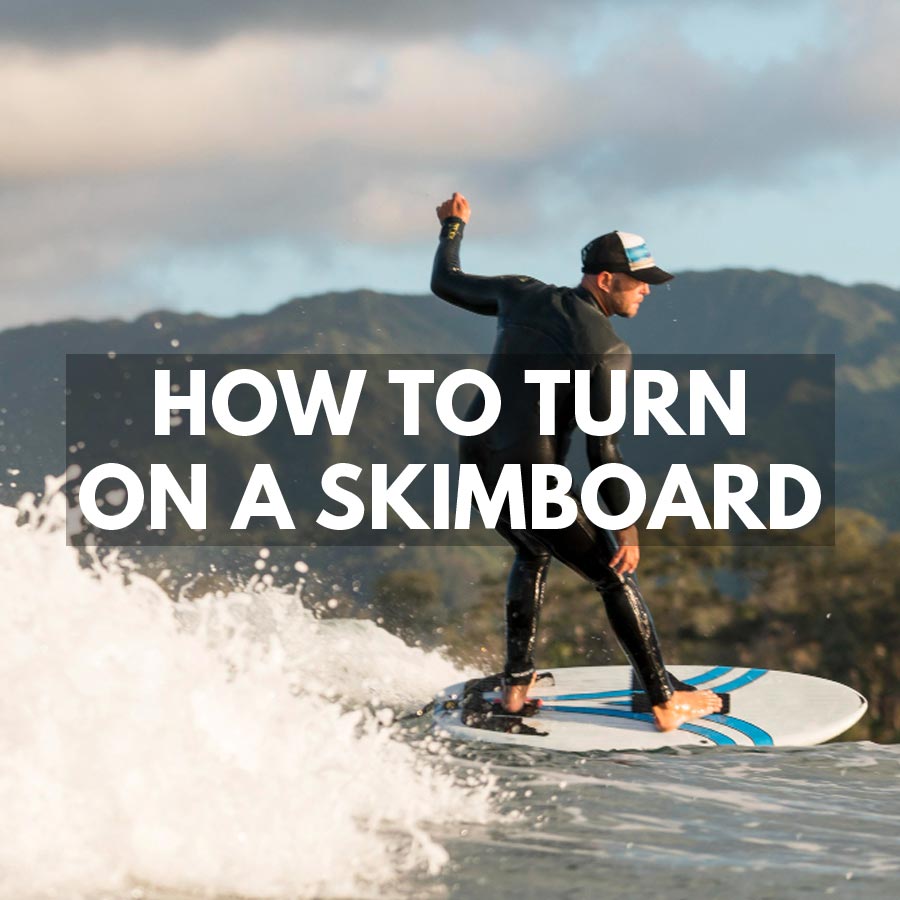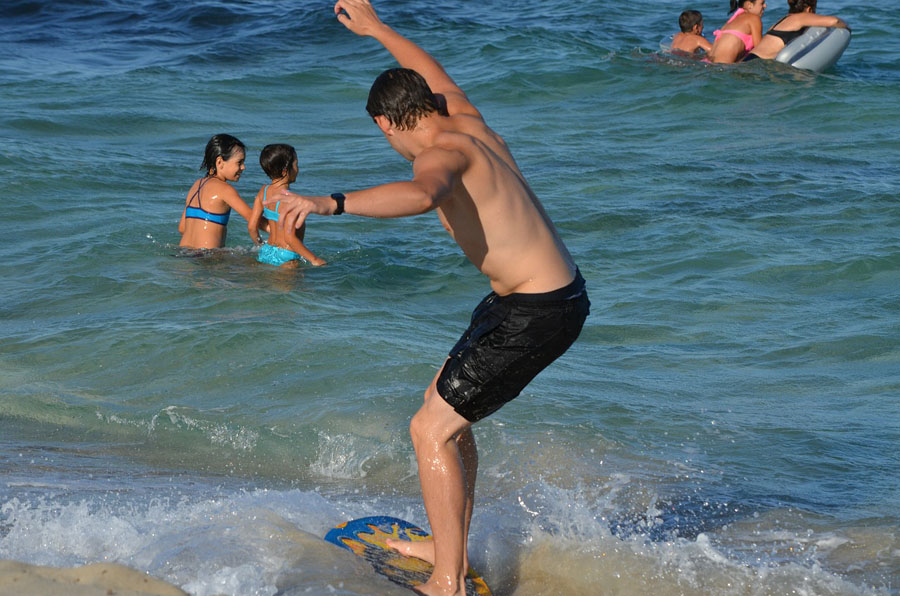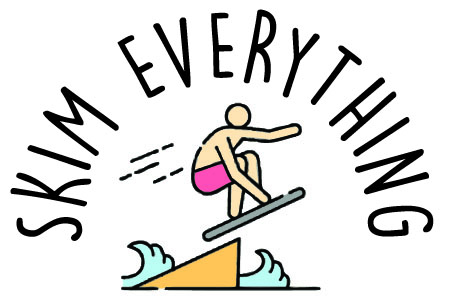
How To Turn On A Skimboard
Learning how to turn on a skimboard is easy with a simple technique that is easy to learn in less than a day. We have broken this down, step-by-step so that you know where to put your feet, the correct stance to take, and where to shift your weight. By the end of this guide, you will understand how to turn on a skimboard using a beginner-friendly approach.
Skimboarding Terms
Before we explain how to turn on a skimboard it is important for you to understand a couple of terms we use throughout the guide. Here are the three phrases you should get to grips with:
“On Rail”
Putting a board “on rail” means rolling the board onto its side edge. The long (side) edges of boards, in water boardsports, are called the “rails”.
The rocker of a board is the banana-like curve running through the horizontal surface of the board. Think “rocking chair”. Putting a board on the rail means that you engage the curve of the board’s rocker into the water, from the rails being in the water.
The water reacting to the rocker curve is what makes the board turn. If there was no curve, there would be no turn. Hence we put the board ‘on rail’ to make it turn.
Frontside or Forehand Turn
If a skimboarder stands left foot forward (natural stance) turning right is forehand/frontside. The opposite is true for right-foot-forward skimboarders.
Backside or Backhand Turn
If a skimboarder stands left foot forward (natural stance) turning left is backhand/backside. Again, the opposite is true for right-foot-forward skimboarders.
Step by Step Guide for Turning a Skimboard
Skimboard turns require a combination of several key movements. These are; posture, balancing, and twisting. We bend our knees while twisting with good posture and lean our skimboards’ edge in the water to make a successful turn.
The Golden Rule
The best tip to improve skimboard turns and carves can be counterintuitive. It is your body that turns, not the board. The board supports you when turning and enables you to turn, but it is your body that creates the path of your turn. Read this twice!
Turning on a skimboard is easy once you understand the basic technique. Learning to steer a skimboard gives you much more control and can enable you to catch waves which is really fun. Check out these fundamentals to get a perfect first turn:
Step 1. Foot position
Your foot position on the skimboard should be about 1.5 shoulder widths. N.B. this may vary from board to board. The arches of your feet should be over the centreline of the board.
Place your back foot near the back of the skimboard and your front foot somewhere in the front half of the skimboard. This will vary depending on your height.
Step 2. Stance: Bend Your Knees
Bending your knees lowers your center of gravity so that you are less likely to fall. Standing too tall is a common mistake. Turning a skimboard is best when you are low. Bend those knees!
Step 3. Twisting: Where You Look Is Where You Go
One of the most overlooked (pun not intentional) fundamentals of turning a skimboard is looking where you want to go. It may seem obvious and too simple. But not looking is one of the biggest mistakes you can make when learning how to turn a skimboard.
Looking is the initiator of the body twist, especially in a backside turn. Looking and pointing the arm in the direction you want to go helps to rotate the shoulders which flows into; the core, hips, knees, and ankles.
The twist is like a coiled spring, loading, and unloading. This transfers some load into the board and sets you up for the turn. If you don’t twist, the board turns and runs off without you because your body wasn’t ready for the new direction.
Step 4. Balancing: Put the Board on The Rail
Turning a skimboard requires the board to be on the rail. So lean, lean, lean. Move your body weight over the toe-side rail and put pressure on your toes to roll the board for a forehand turn. For a backhand turn, move your weight over the heel-side rail and use heel pressure.
Good posture is important when turning on a skimboard. So don’t stand tall like the leaning tower of Pisa, bend your legs and get your butt down.
Step 5. Even Weight Distribution
Skimboards turn most like a snowboard due to their lack of fins. They rely solely on the edge of the board in the water to provide the counterbalance force to your lean. This means that turning a skimboard needs an equal or slightly front foot biased weight distribution.
Too much weight on your back foot will make the board skip out, or spin instead of turn. On a wave, you can get away with more weight on the back foot (and sometimes it’s helpful to do so!) because of the extra support given by the wave’s face and power.
Step 6. Carve Through The Turn: Use Your Legs
We’re down low, we’re a coiled spring, and our arms are pointing in the direction we want to go. Now is the time to push through the turn with our legs. This releases our loaded up energy through the board and into the water to make our turn perfect.
Step 7. Be patient
Turning a skimboard takes different amounts of effort, lean & twist for different turns. Turning on, or into, a wave can support more of a lean than on the flats. It will take some time and repetition to find the sweet spot of all these techniques.
How to Practice Turning on a Skimboard
Using the step-by-step guide above, you can practice turning on a skimboard and get a little bit better each time. The more you practice the faster you will improve so try and get out there every day if you can.
If you can’t get to the ocean every day to practice there are some other ways you can improve your skills and balance. Skateboarding, longboarding, snowboarding, and balance boards are all great ways of practicing skimboarding without using a skimboard.
The best practice, away from the water, is using a surfskate. These are relatively new and are like a skateboard with a different front truck. The front truck on surfskates allows a better posture when turning.
Practicing on land is tricky because we cannot practice the lean properly without falling over. Practicing without proper technique can create bad habits which actually hurt our progress in the water! So be mindful of our above tips in your land practice.
Surfskates let us lean better.
How to Improve Your Turns when Skimboarding
To improve your turns on a skimboard means adapting the right turn for the right situation. Waves give you support. So you can turn harder, lean more and use more back foot weight when on waves.
Try changing your weight distribution for different turns and see what happens. More even weight distribution for flatter water and more back foot weight for wave turns.
Timing your turns well will improve your turns also. Turning a skimboard early enough so you do not hit the wave, but rather cruise into it, will improve the turn outcomes.

4 Problems You May Encounter When Learning to Turn On a Skimboard
Here are some common problems you may run across when practicing how to turn a skimboard:
1. Wrong Turn Wrong Place
The “arc” of our turn is the circular path that we trace out while turning. A tight arc is a small turning radius with a fast directional change. A shallow arc is a bigger more drawn-out turn.
Sometimes we need a tight turn and sometimes we need a long-drawn-out carve. This depends on the situation and takes some trial and error to figure out.
Trying to turn your skimboard in an arc that is too tight with not enough speed results in falling off. If you are constantly falling off, try adjusting your turning arc or get more speed.
2. Skimboard “Skipping Out”
If your board is slipping out from under you in a turn, it is usually due to one (or more) of three things.
- Not enough rail in the water. You’re leaning but don’t have rail support. Fix this by putting more pressure on the appropriate end of the foot (toe or heel).
- Wrong weight distribution. If the back is skipping out, put more weight on the front foot.
- Standing too tall and leaning too far. This means you have more leverage than the rail can support. Get lower!
3. Not Turning
If your skimboard is not turning you may have too much weight on the front foot. Even up the weight distribution. It’s also possible you don’t have enough rail in the water. Put the board on the rail!
4. Spinning Instead of Turning
A skimboard spinning instead of turning means a lack of speed or rail in the water. The curved rail makes the turn possible. If the skimboard is spinning, then it’s too flat. Put it on the rail!
Hopefully, this guide has helped you understand how to turn on a skimboard without falling off. Feel free to get in touch with any questions and check out our latest skimboarding articles.






